1.1 Nature of Economics
1/46
There's no tags or description
Looks like no tags are added yet.
Name | Mastery | Learn | Test | Matching | Spaced |
|---|
No study sessions yet.
47 Terms
Ceteris paribus
The assumption that whilst the effects of one variable are being considered, all other relevant variables are held constant
"All other things being considered"
Economists vs scientists
Scientists can use experiments to prove/disprove theories, whereby all external variables are controlled
Economists cannot conduct experiments to prove/disprove theories, given that economic experiments are too large to test in a lab setting; moreover, economic variables are unpredictable and hard to control
Models
A representation of something real, often in a simplified or a small scale manner
Reliance on models
Economists use models to study economic behaviour and economic systems
Validating theories
Economists use calculations to validate theories, but they must also make assumptions when using simplified models, as economic systems are so complex, thus they are allowed to make predictions
Positive statements
A statement that can be supported or refuted by evidence
Value judgements
A statement based on your opinion or beliefs, rather than facts
Normative statements
A statement that cannot be supported or refuted by evidence, as it is a value judgement
The role of value judgements in economic decisions
When making economic decisions, a government, firm or consumer may need to make value judgments because it is difficult to prove the outcome of a decision in economics
The basic economic problem
There is an unlimited set of wants and needs, but there is a limited amount of resources
Renewable resources
Renewable resources can be replenished, hence the opportunity cost is lower
Non-renewable resources
Non-renewable resources cannot be replenished, thus it would eventually run-out
Opportunity cost
The value of the next best forgone alternative forgone when making a choice
The importance of opportunity cost to economic agents
When making economic decisions, economic agents may need to make value judgements as it is difficult to prove the outcome of some decisions as they are inherently normative
Factors of production
Land - natural physical resources (farmland), reward = rent
Labour - human input into production (workers), reward = wages
Capital - man-made inputs used in the production process (machinery), reward = interest
Enterprise - an individual who supplies a good or service (self-employed), reward = profit
Production possibility frontiers
Demonstrates the maximum possible output of two goods/services in any combination, assuming a fixed amount of starting resources
PPF as an economic model
The PPF is a model of production and the behaviour of PRODUCERS
It is also effectively a model of scarcity, hence it also demonstrates opportunity cost and choice
PPF's to depict maximum productivity
Points on the CURVED diagram indicate an economy operating at maximum productivity
Macroeconomic PPF
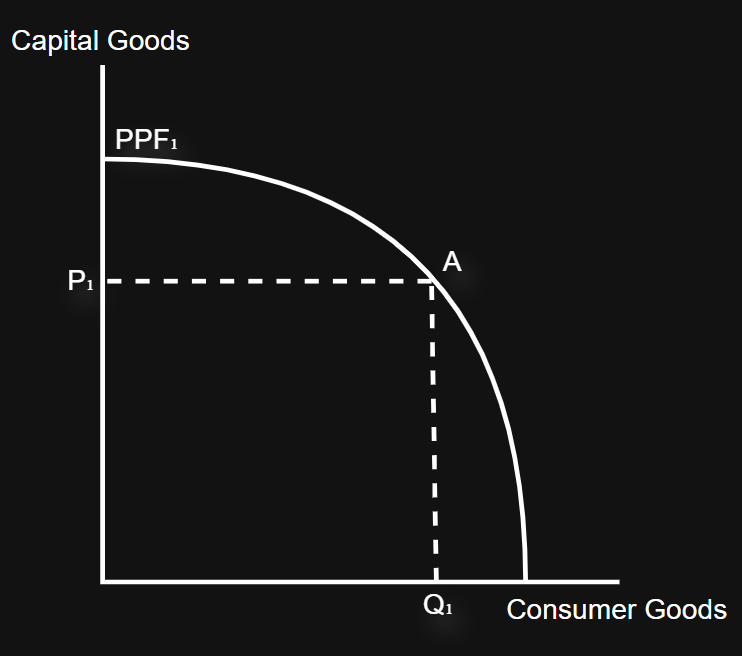
PPF's to depict opportunity cost
Opportunity cost increases as the line approaches the intercepts
Microeconomic diagram
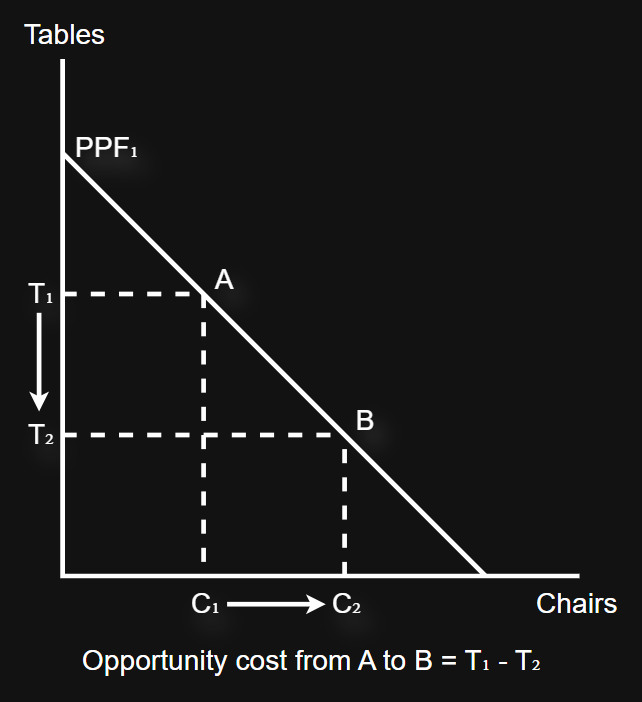
PPF's to depict economic growth/decline
A leftward shift in the PPF curve indicates a decline in the economy
A rightward shift in the PPF curve indicates a growth in the economy
Macroeconomic curved diagram
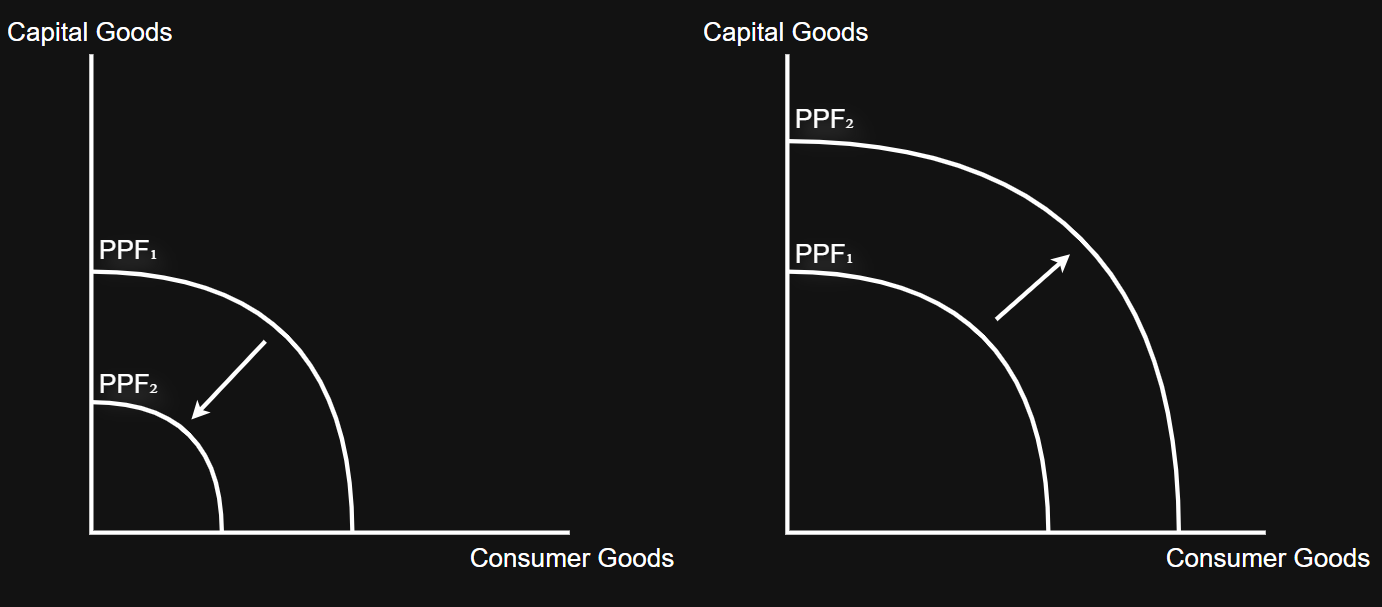
PPF's to depict inefficient allocation of resources
Points inside the PPF curve indicate an inefficient allocation of resources
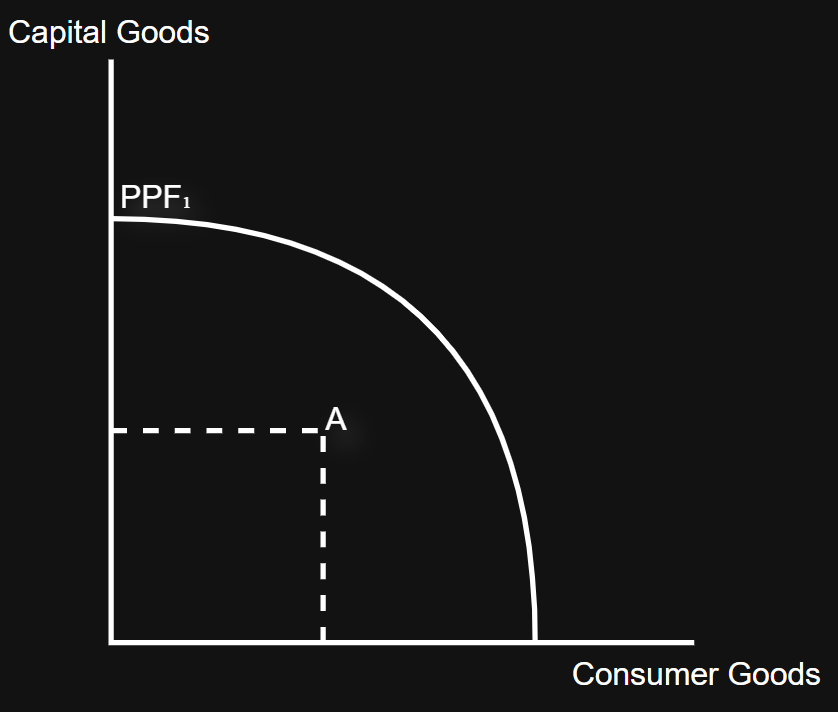
PPF's to depict impossible production
Points outside the PPF curve indicate impossible production
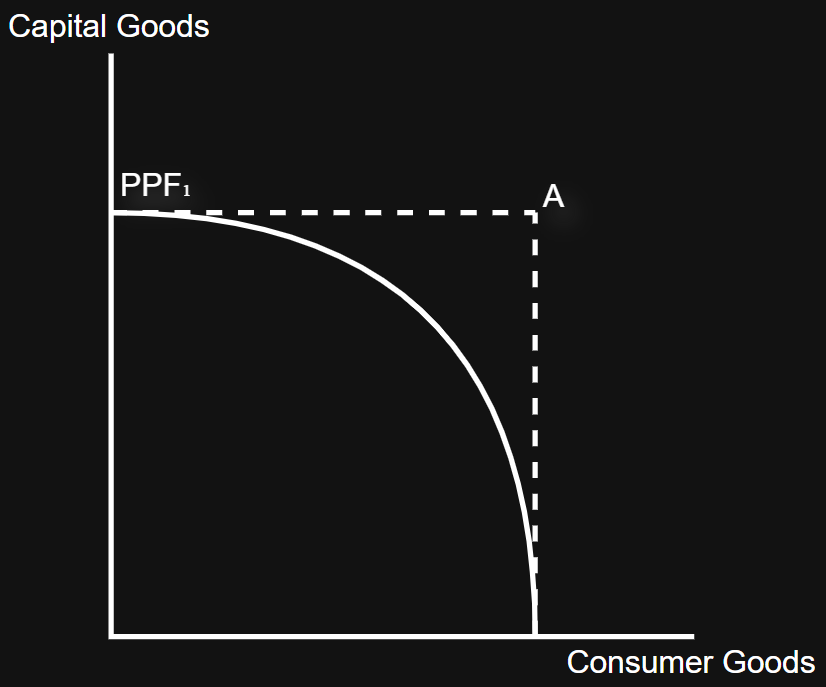
Linear microeconomic diagrams
Linear microeconomic diagrams are drawn when both products on the axis require unspecialised resources
(e.g. tables and chairs both require wood)
Curved microeconomic diagrams
Curved microeconomic diagrams are drawn when both products on the axis require specialised resources
(e.g. planes and chairs both require different resources)
Macroeconomic PPF curve
A macroeconomic PPF curve is a diagram of all goods
The x and y axes are labelled as consumer and capital goods
Anywhere on the curve indicates the economy has reached maximum productive potential
Movement in a PPF curve
A movement in the PPF curve causes both the x and y values to change
In a curved diagram, a relatively large decrease in the value of y causes a small increase in the x value, and vice versa
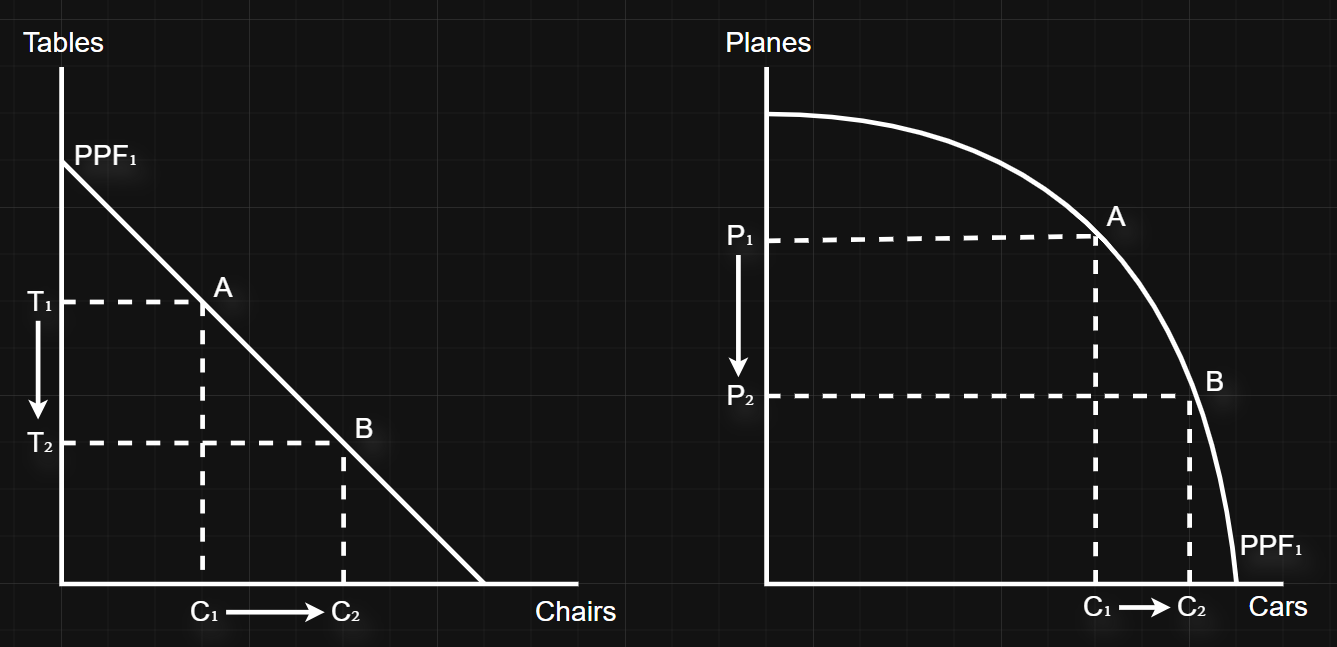
Causes of a movement in a PPF curve
A firm decides to alter the distribution of resources to one of the two products
Shift in a PPF curve
A shift in the PPF curve can cause the x value to change without a change in the y value, and vice versa
Hence, there is no opportunity cost as the x value can stay the same whilst the y value changes
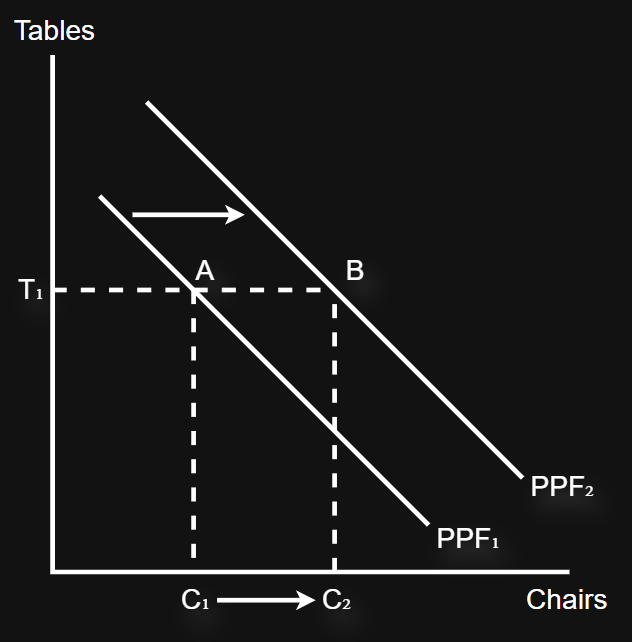
Causes of a shift in a PPF curve
More initial resources; if there is more input into production, the maximum possible output increases
More productive means to combine resources (better machinery or technology); if resources can be used in a more productive/efficient manner, the maximum output with a given input increases
A pivot in a PPF curve
A pivot represents productivity improvements in one output of a good, which does not affect the other
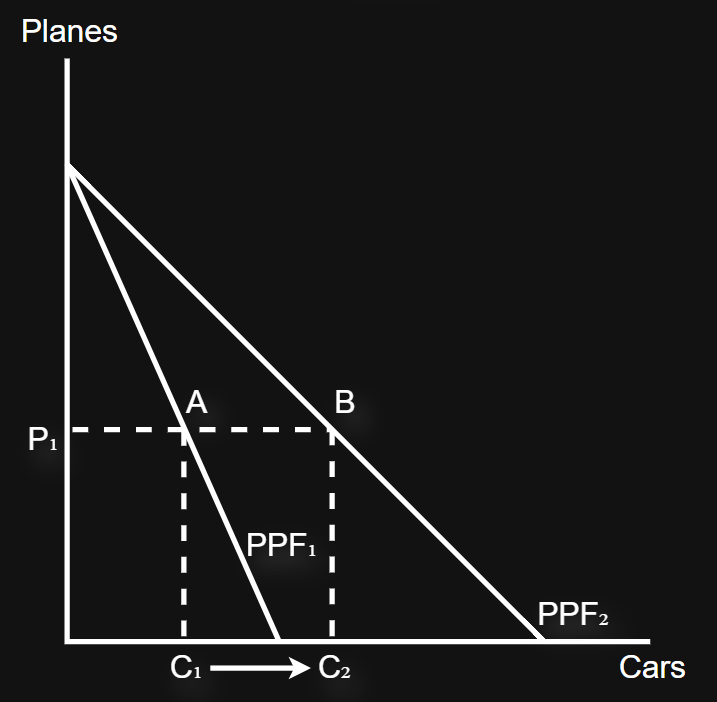
Capital goods
Goods used by producers to consume other goods, e.g. machinery/tools
Consumer goods
Good used by consumers for satisfaction
Specialisation
When a country, economy or firm concentrates on producing a certain good or service
Division of labour
The process where the production of a good is broken down into many separate tasks, each performed by different workers
Adam Smith
Advantages of specialisation
More efficient in producing a good or service
They benefit from economies of scale, increased output = lower average costs
Disadvantages of specialisation
Overreliance on a certain good
(e.g. Cuba specialises in producing sugar, and if the sugar price decreases so will the Cuban economy)
Advantages of division of labour for firms
Higher productivity = higher output
Workers only need to be trained for their certain area of expertise, saving time and money
Disadvantages of division of labour for firms
Only works for large-scale production
High staff turnover costs as they get bored
Hard to find a replacement for a specialised worker
Advantages of division of labour for workers
Higher wages
Workers can become an expert in a field of work
Workers can make use of their skills or qualifications
Disadvantages of division of labour for workers
Workers get bored, potentially leading to inefficiency
Money
Money is seen as an intermediary good given that it is not a factor of production or a consumer good
Functions of money - medium of exchange
Medium of exchange; money is a resource solely used for exchange, this function encourages more trade/exchange because it avoids the double coincidence of wants (used in a barter economy)
Functions of money - store of value
Store of value (assuming no inflation); for those who sell perishable or depreciating products (farmers), money allows them to sell their output and retain the value of it for future spending
Functions of money - unit of account (measure of value)
Unit of account; by providing a universal measure of the value/worth of all goods and services, it makes price listing much easier, comparing prices is more efficient and less time consuming, as values do not need to be converted like in a barter economy, quicker/easier trade/exchange = more trade/exchange
Functions of money - standard of deferred payment
Standard of deferred payment; because money stores its value, it is also acceptable as a means of delayed payment, allowing economic agents to move their purchasing power from the future to the present
(e.g. when taking out a loan, we sacrifice the ability to consume in the future for the ability to consume in the present)
How money enables greater specialisation
Without money (in a barter economy), it would be very risky for producers who don't produce necessities to specialise as necessity producers (farmers) might not want to trade for your products
Therefore, money solves the double coincidence of wants, it removes the risk from specialisation
(e.g. if Mr Dyas wanted to offer a farmer his economics tuition for food, the trade may not happen as the farmer may not want economics tuition)